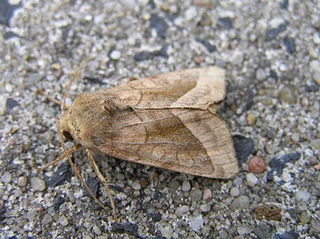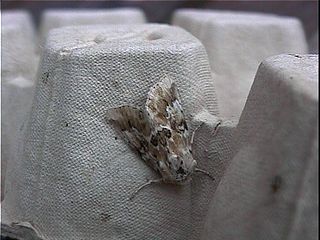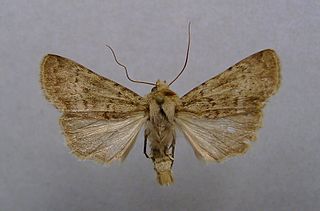
The six-striped rustic is a moth of the family Noctuidae. It is distributed throughout Europe apart from the far south east.

The minor shoulder-knot is a moth of the family Noctuidae. The species was first described by Johan Christian Fabricius in 1776. It is distributed throughout Europe then east across the Palearctic to Siberia and Japan. It also occurs in Turkey.

Lygephila pastinum, the blackneck, is a moth of the family Erebidae. The species was first described by Georg Friedrich Treitschke in 1826. It is found in Europe and across the Palearctic Siberia, the Russian Far East, Japan and China.

Lacanobia thalassina, the pale-shouldered brocade, is a moth of the family Noctuidae. It is found in Europe east across the Palearctic to the Russian Far East and Siberia.

Hydraecia micacea, the rosy rustic, is a moth of the family Noctuoidea. It is found across the Palearctic realm from Ireland to Siberia. It reaches Japan and is introduced to eastern USA, Quebec and Ottawa.

Hoplodrina blanda is a moth of the family Noctuidae. It is found in the Palearctic realm.

Hoplodrina ambigua, the Vine's rustic, is a moth of the family Noctuidae. It is found in the western Palearctic realm.

Allophyes oxyacanthae, the green-brindled crescent, is a moth of the family Noctuidae, found in Europe. The species was described by Carl Linnaeus in his landmark 1758 10th edition of Systema Naturae.

Eremobia ochroleuca, the dusky sallow, is a moth of the family Noctuidae. It is found in Central and Southern Europe and the Middle East.

The Essex y is a moth of the family Noctuidae. It is found from Italy to Greece, southeastern Europe, southwestern Russia, the southern parts of the Ural, Africa, Canary Islands, Arabia, southwestern Asia, Ceylon, from India to Nepal, southeastern China and Japan.

Lygephila craccae, the scarce blackneck, is a moth of the family Erebidae. It is found in temperate Europe and across the Palearctic to the Altai Mountains, Korea, Japan and China.

Cosmia diffinis, the white-spotted pinion, is a moth of the family Noctuidae The species was first described by Carl Linnaeus in 1767. It is found in central and southern Europe, to the north it is found up to central England and the southern parts of the Netherlands. There is a disjunct population in Gotland. To the south, it is found down to Spain, Italy, Russia, northern Greece and Bulgaria. In the east, it is found as far as Lithuania and the Black Sea.

Leucania punctosa is a species of moth of the family Noctuidae. It is found from Morocco to Libya, southern Europe, Turkey, Armenia, Israel, Lebanon, Jordan, the Sinai in Egypt, Iran, Iraq and Turkmenistan.

Apamea zeta is a moth of the family Noctuidae. It has a Holarctic distribution, and can be found throughout the Northern Hemisphere. It occurs throughout Europe and the northern half of North America.

Epipsilia latens is a moth of the family Noctuidae. It is found in central Europe, northern Spain, the Apennines, northern Iran, Turkey, Armenia and the Caucasus.

Euxoa hastifera is a moth of the family Noctuidae. It is found from southern Europe to Siberia and Tajikistan.

Dichagyris signifera is a moth of the family Noctuidae. It is found from Spain and France, east through central and southern Europe to Latvia and Russia.

Athetis pallustris, the marsh moth, is a moth of the family Noctuidae. It is found in most of Europe, the southern Urals, southern Russia, Ukraine, eastern Turkey, Siberia, the Amur region, the Russian Far East, Mongolia and northern China.

Parastichtis suspecta, the suspected, is a species of moth in the family Noctuidae. It is found from most of Europe through Russia and east through the Palearctic to Japan. It is also found in North America.

Cleonymia yvanii is a moth of the family Noctuidae first described by Philogène Auguste Joseph Duponchel in 1833. It is found in Portugal, north-eastern Spain, southern France and north-eastern Italy.



















